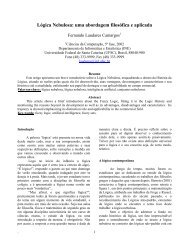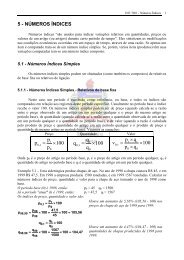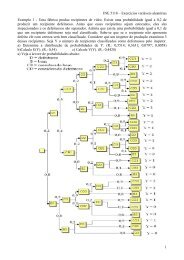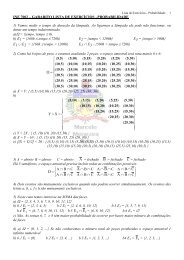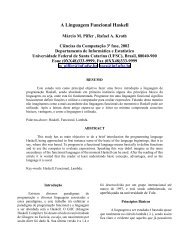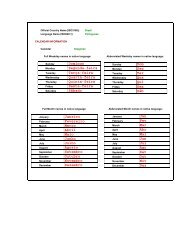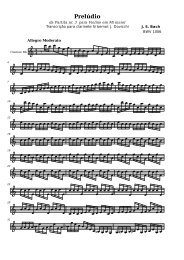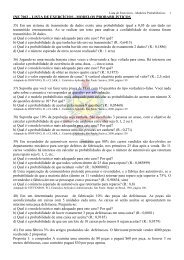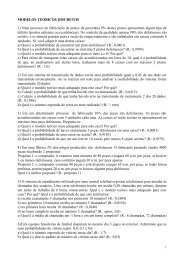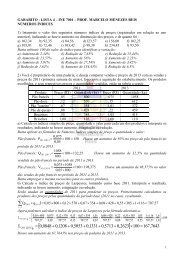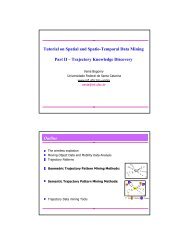Anais do IHC'2001 - Departamento de Informática e Estatística - UFSC
Anais do IHC'2001 - Departamento de Informática e Estatística - UFSC
Anais do IHC'2001 - Departamento de Informática e Estatística - UFSC
Create successful ePaper yourself
Turn your PDF publications into a flip-book with our unique Google optimized e-Paper software.
<strong>Anais</strong> <strong>do</strong> IHC’2001 - IV Workshop sobre Fatores Humanos em Sistemas Computacionais 237<br />
construction of the diagram [Wang et al., 1995]. A closer examination of Figure 4 might<br />
give elements to support the interpretation that some H are A, which is not a valid logic<br />
conclusion. An attempt to correct this representation by removing the intersection between<br />
circle H and circle A, as shown in Figure 5, would also lead to interpretations that are<br />
logically incorrect (i.e. that no A is H).<br />
Figure 5: An alternative representation for “all humans are breast-fed and some<br />
animals are not breast-fed; therefore some animals are not human”<br />
This situation has motivated research in different directions. Wang et al. (1995) have<br />
proposed a series of rules and constraints for constructing good diagrammatic<br />
representations. Stenning and In<strong>de</strong>r (1995) and Stenning and Oberlan<strong>de</strong>r (1995) have<br />
chosen another path and explored mo<strong>de</strong>s, media, and expressiveness of representation<br />
systems. The latter have proposed a hierarchy of representation systems (minimal<br />
abstraction systems, limited abstraction systems, and unlimited abstraction systems) and<br />
have provi<strong>de</strong>d experimental cognitive evi<strong>de</strong>nce that limited abstraction representation<br />
systems (LARS), which allow for representing in<strong>de</strong>terminacy are better as cognitive<br />
scaffolding in learning than minimal (MARS) and unlimited abstraction representation<br />
systems (UARS). It is interesting to notice that the problem with either Figures 4 or 5 is<br />
their excessive <strong>de</strong>gree of (emergent) <strong>de</strong>termination with respect to the relation between H<br />
and A.<br />
Stenning and In<strong>de</strong>r (1995) have also analyzed matrices and tables as graphic<br />
representations. They have conclu<strong>de</strong>d that these kinds of visual aids can only represent data<br />
that is fully specified on the dimensions present in the matrix. Partially <strong>de</strong>termined data<br />
cannot be represented, for the assignment of data to a cell automatically specifies its value<br />
in all of the table’s dimensions. This observation has an interesting consequence for<br />
teaching Men<strong>de</strong>l’s laws of heredity with the use of Punnet Squares (see Figure 6).<br />
If we take the Law of Dominance, for example, we can use the Punnet Square to represent<br />
the principle that “when crossing parents with pure contrasting heredity traits, the next<br />
generation of individuals will exhibit the characteristic of only one of the contrasting<br />
traits”. The Punnet Square is a matrix (a table) where the traits of the female and male<br />
parents are displayed in the first column and first row. The possibilities of genetic<br />
combinations are displayed in the cells of the table, by the concatenation of co<strong>de</strong>s used to<br />
represent each heredity trait. Figure 6 shows a Punnet Square for the crossing of two pure<br />
types: tall-stem pea (TT) and a short-stem pea (tt). The principle is represented by the fact<br />
that all genetic combinations of the offspring are Tt. Observably, this corresponds to the<br />
fact that the individuals show the characteristics of trait ‘T’, <strong>de</strong>spite the presence of trait ‘t’<br />
in their chromosomes.<br />
T T<br />
t Tt Tt<br />
t Tt Tt<br />
Figure 6: The Punnet Square representing Men<strong>de</strong>l’s Law of Dominance



